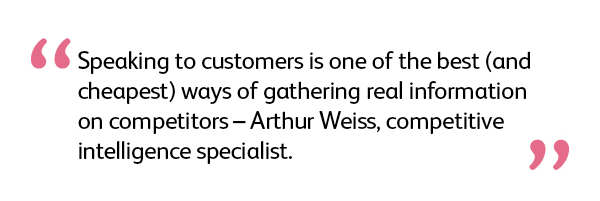Should you compare your business to your competitors? As an owner of a salon, spa or clinic, it’s important to have your fingers firmly on the pulse of your own business as well as what’s going on around you, especially when the hair and beauty industry is so competitive.
Therefore, it’s useful to keep an eye on your competitors. Your competition can help you make informed decisions, and you can learn from them what works and what doesn’t. But don’t fall into the trap of worrying about every little step they take – it will drive you mad! You need to take a considered approach.
Of course, you do need to create a market space for your brand – an identity that drives everything you do. Every salon, spa or clinic should have an area that sets it apart from the competition. That’s your Unique Selling Proposition (USP).
We wanted to give you some simple, actionable initiatives so you can start seeing how your business measures up.
Here’s how to effectively compare your business to your competitors in a way that is positive and can help grow your business.
Assess strengths, weaknesses and trends
What are your competitors’ strengths and weaknesses? What trends do you see in the market when you consider your competitors as a group? What opportunities and threats do these trends present to you?
For example, given the trends, what are you most excited about pursuing? Do you have a new package that will set you apart from the competition? What are you most worried about – how could your competitors derail your plans?
Ideally, your competitor analysis should give you hard-hitting insights into your overall marketing strategy, such as:
- What makes your brand unique.
- Which types of customers you are really targeting (young, old, family, price conscious, wealthy, location driven).
- Where and how to advertise and promote your business.
- Which services or packages to emphasize
Ask your clients
When it comes to identifying sources of information about your competition, don’t skip over the obvious ones – like your clients.
“Speaking to customers is one of the best (and cheapest) ways of gathering real information on competitors, says Arthur Weiss, a specialist in competitive intelligence.
Whenever you win a new customer, find out who they used before, and why they switched to you (i.e. The reason they were dissatisfied with their previous supplier). Do the same when you lose a customer—identify what they preferred about your competitor.
Arthur Weiss went on to say If you gather enough of these stories you’ll get a very clear idea on what competitors are offering that customers view as preferable. You can then adjust your own offering to beat that of the competitor.”
Ask industry experts
The hair and beauty industry has a number of experts. Some of them advertise their services as a business coach or advisor, others fly under the radar. Ask your friends and contacts who they know of and recommend as being an industry expert that you can go to for advice about how your business compares.
Use software to provide industry insights
Can you say with certainty how you’re faring against your competitors? Do you know what the average industry rebooking rate is? How does your average client spend compare?
You can easily find this out by using salon software. These are the metrics that really matter, and it can be incredibly motivating to see what other businesses like yours are achieving so it gives you a benchmark.
Use industry benchmarking by Kitomba
Kitomba Benchmark gives you a true warts-and-all account of where your business stands against the industry.
Belinda Watson of Biba Boutique Salon in Auckland said, “It enables us to monitor the results that drive bottom line profitability on a daily basis, as well as benchmarking ourselves against other salons. It’s both motivating and inspiring. It’s like having a business coach with you 24/7.”
Kitomba Benchmark can be found in the reports section of Kitomba.
Why should you benchmark your business?
Benchmarking your business enables you to be strategic in your decision making. Benchmarking allows you to move beyond making decisions based purely on popular opinion.
You won’t need to wonder if it’s just your business that’s having a quiet few months, or if your sales targets are attainable or not, because benchmarking gives you the market intelligence you need to make the right decisions for your business, identify opportunities for growth and uncover potential threats early.
Benchmark uses live data so you always know exactly where you sit against the industry and what the industry average is. Our industry is changing – the data shows it. As the economy fluctuates and client behaviour and business performance changes, so does Benchmark.
How does your business compare?
Use the tips above to conduct competitor analysis to see how you’re tracking and find new ways to grow your business.
If you’d like to find out new ways of growing your business, download our free e-book 100 ways to grow. It contains 100 different ways to improve your business and drive more revenue that you can start using right away!
If you want to find out how Kitomba Salon and Spa Software can help you to grow your business and conduct competitor analysis through benchmarking, book your free demo.
Get more business tips for salons, spas and clinics
Want to learn more ways to grow your business?
Read next:
- How to measure the success of your business
- The elements of a perfect client consultation
- How to introduce targets to your team
Editor’s note: This post was originally published on 10 November 2016 and has been updated for accuracy and comprehensiveness.









i WOULD LIKE TO KNOW IF THERE IS A POSSIBILITY WHEN WE SELL A GIFT VOUCHER TO HAVE IT PUT DIRECTLY UNDER INTERNAL , WHEN WE REDEEM THE VOUCHER THEN THE TREATMENT GOES UNDER
THE STAFF MEMBER AND THEN ADDED TO THEIR FIGURES IS THAT POSSIBLE?
Hi Brigitte,
Kitomba uses accrual based accounting for vouchers, so when a voucher is sold it isn’t included in your total sales until it’s redeemed. This prevents double counting.
In your business summary report, under vouchers & concessions, your in-store voucher sales are the vouchers sold for the period, which won’t be included under your total sales. However, vouchers received will be included in your total sales.
If you’d like to find out more, read this support guide: https://support.kitomba.com/hc/en-us/articles/225368187-Vouchers-and-accounting
I hope this helps! Please contact us if you have any questions.
Janelle